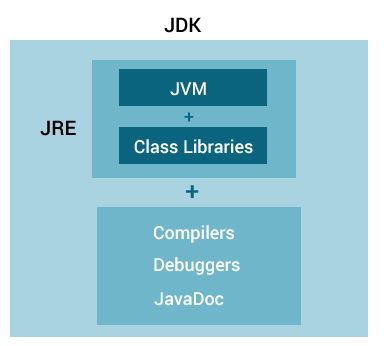
|
| UNDERSTANDING THE JAVA ECOSYSTEM |
Java is a popular, object-oriented programming language that is widely used for developing various applications and software. It is also one of the most popular programming languages in the world. Java is often mentioned along with three other terms: Java Development Kit (JDK), Java Runtime Environment (JRE), and Java Virtual Machine (JVM).
In this blog post, we'll take a closer look at these three terms and understand the differences between them.
1) Java Development Kit (JDK)
2) Java Runtime Environment (JRE)
The Java Runtime Environment (JRE) is a subset of the JDK that contains only the Java Virtual Machine (JVM) and the necessary libraries and files needed to run Java applications. The JRE is the software that enables users to run Java programs on their computers.3) Java Virtual Machine (JVM)
The Java Virtual Machine (JVM) is a crucial component of the Java ecosystem. It is a virtual machine that provides the environment to run Java applications. The JVM interprets compiled Java code and executes it on the computer. It provides a standard environment for running Java applications and ensures that the same code runs on any computer, regardless of the hardware or operating system.
Relationship between JVM, JRE, and JDK.
The Java Development Kit (JDK) is the complete software development environment for Java. It includes the Java Runtime Environment (JRE) and all the tools and libraries needed to develop Java applications.
The Java Runtime Environment (JRE) is the software platform that allows Java applications to run on a computer. It includes the Java Virtual Machine (JVM) and all the necessary libraries and files required to run Java applications.
The Java Virtual Machine (JVM) is the component that actually executes the Java code. It interprets the compiled Java code and provides a standard environment for executing it on any computer, regardless of the hardware or operating system.
In summary, the JDK is a complete software development environment that includes the JRE, which is necessary to run Java applications. The JRE includes the JVM, which is responsible for executing the Java code.
Differences between JDK, JRE and JVM
Purpose:
JDK is used for developing Java applications, JRE is used to run Java applications, and JVM is the virtual machine that runs Java code.
Content:
JDK contains both JRE and JVM, JRE contains only JVM, and JVM is the component that interprets and executes the Java code.
Functionality:
In conclusion, JDK, JRE, and JVM are three important components of the Java ecosystem. They serve different purposes, but they work together to make it possible to develop and run Java applications. If you are a Java developer, it is important to understand the differences between these three components.

.jpg)




.jpg)
